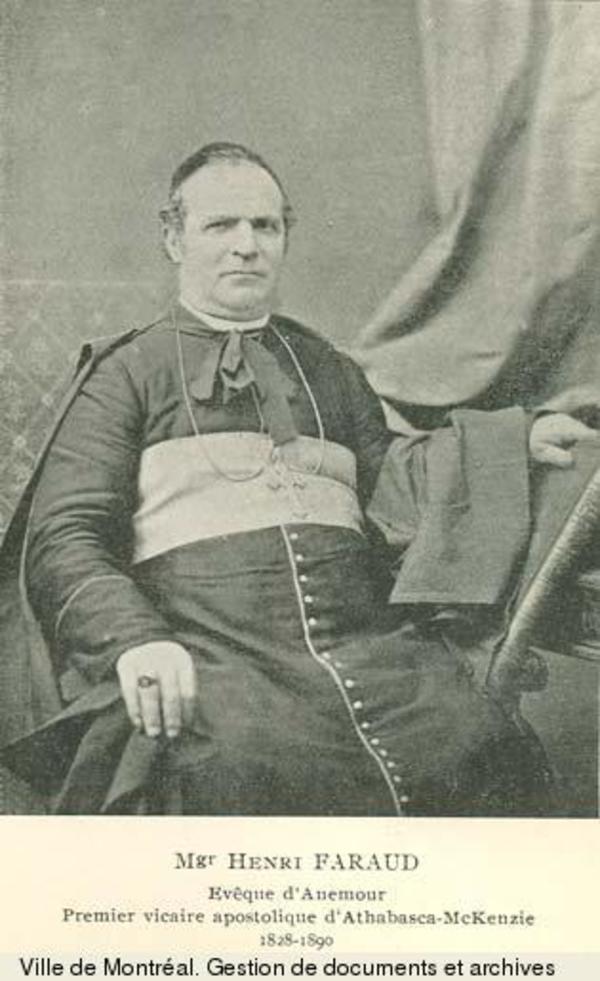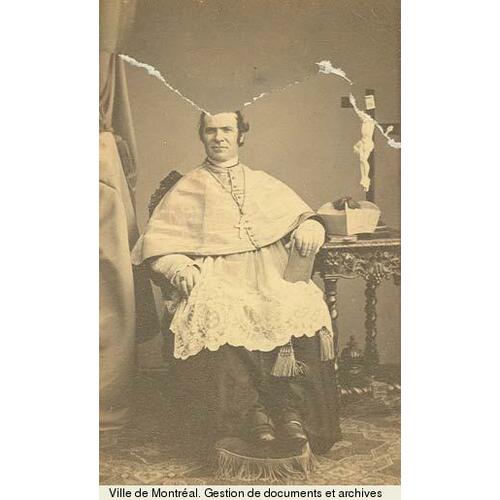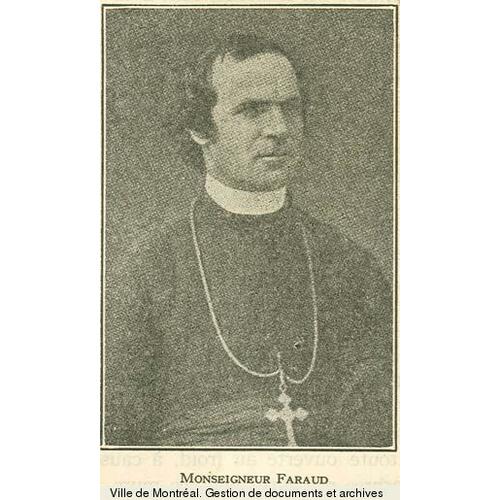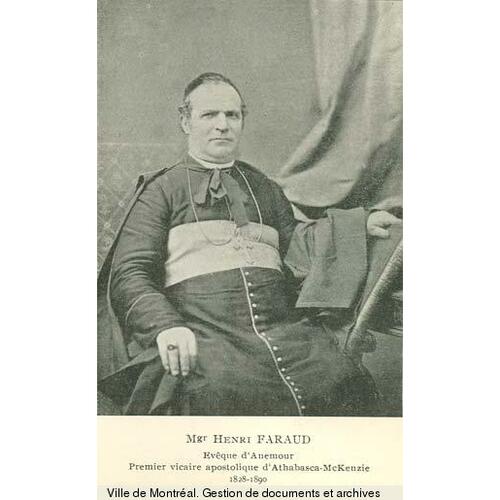
Source: Link
FARAUD, HENRI, priest, Oblate of Mary Immaculate, missionary, bishop, and author; b. 17 June 1823 at Gigondas, dept of Vaucluse, France, the youngest of the six children of François-Xavier Faraud and Madeleine Faurye; d. 26 Sept. 1890 at St Boniface, Man.
Henri Faraud received a classical education at the minor seminary of Notre-Dame-de-Lumières at Goult. He took his perpetual vows in 1844 and then spent two years studying for the priesthood at Notre-Dame de l’Osier, Isère. When Bishop Joseph-Norbert Provencher* sought additional missionaries to work with him in the northwest, Charles-Joseph-Eugène de Mazenod, the bishop of Marseilles and founder of the Oblates of Mary Immaculate, named Faraud to the missions in America. Leaving on 3 June 1846, Faraud reached St Boniface on 8 November after an arduous journey. While continuing his theological studies he worked with Abbé George-Antoine Bellecourt* until June 1847 to familiarize himself with Indian customs and the Ojibwa language. Made a sub-deacon in late April 1847 and a deacon on 1 May Faraud was ordained priest seven days later. That summer he went with Pierre Aubert, the Oblate superior of the region, to minister to the Ojibwa Indians of Wabassimong (Whitedog, Ont.). However, the mission was quickly abandoned because of the apathy of the Indians, and by the end of July the two priests were back at St Boniface.
In June 1848 Bishop Provencher sent Faraud to replace Louis-François Laflèche* at Île-à-la-Crosse (Sask.); he worked there with Alexandre-Antonin Taché* who became a close friend. A year later he was appointed missionary in charge of the vast Lake Athabasca district. Faraud travelled from Île-à-la-Crosse over the Portage La Loche (Sask.) route, one of the Hudson’s Bay Company’s canoes taking him on board. By September he had reached Fort Chipewyan (Alta), where he established the first Catholic mission in the region, naming it La Nativité. For 10 months in 1849–50, Faraud laboured alone in the mission which served an area stretching from the Peace River to the Arctic Ocean. Then, feeling the need for personal renewal through contact with his fellow priests, he made the 750-mile return trip from La Nativité to Île-à-la-Crosse. In October 1852 his first companion, Father Pierre-Henri Grollier*, arrived at Lake Athabasca. Faraud set up a permanent mission at Fort Resolution (N.W.T.), on Great Slave Lake. When Bishop Provencher died in 1853, Taché succeeded him as superior of the Oblates in the west, and he chose Faraud as one of his councillors.
Foreseeing the Hudson’s Bay Company’s loss of its monopoly of the fur trade, and subsequent refusal to transport missionaries and their stores, in 1855 Bishop Taché got Faraud to agree that the mission at Lake La Biche (Alta) should become the supply base and point of departure for journeys to the north. Fathers Jean Tissot and Augustin Maisonneuve were dispatched to the mission in order to move it to a more suitable location six miles from Fort Lac-la-Biche and put it on a firm footing; they introduced farming on a large scale, and in 1856 even laid a 100-mile corduroy road to Fort Pitt (Sask.) for Red River carts. In 1855 Father Vital-Justin Grandin* and Brother Patrick Bowes had received their authorizations to come to the Athabasca district, and Brother Alexis Reynard* arrived the following year. These new recruits made it possible for Faraud to carry the gospel ever farther afield and in the course of time some 20 other missions were established.
Without Faraud’s knowledge Taché and Grandin joined the archdiocese of Quebec in 1860 to request Rome to detach the Athabasca–Mackenzie district from the diocese of St Boniface as a vicariate apostolic, and to appoint Faraud its first incumbent. To facilitate matters Faraud was summoned in 1861 to Île-à-la-Crosse, which was closer to St Boniface, and Grandin undertook a three-year tour of the northern missions. Taché, when he went to Paris to attend the general chapter of the Oblates, also paid a visit to the Vatican, where his plan was adopted and the papal bulls were signed on 13 May 1863. In August Faraud left for Europe, and on 30 November he was consecrated bishop of Anemour.
On his return Faraud stayed in Montreal for a couple of weeks to supervise the printing of some books in Indian languages which he had put together over the years. He had also taught reading in syllabic signs to many of his flock. At the end of the summer of 1865 he made his way to his vicariate via the Portage La Loche. His life as a missionary did not change significantly, but his responsibilities increased. Anticipating his inability to cope with them single-handed, he had secured permission from Pius IX on 3 Aug. 1864 to select an auxiliary without right of succession; he was to make his choice in consultation with the vicariate’s staff and to consecrate him in the north. Isidore Clut*, who had been his assistant at La Nativité since 1858, was selected and appointed bishop of Arindel in 1864.
Faraud spent the next two decades at Lake La Biche, which became his episcopal see in 1869. He left it only three times: in 1872 he travelled to Europe where he spent two years begging for help to ensure the survival of his missions; in 1879–80 he undertook a visitation of his vicariate; and in 1889 he was summoned to St Boniface by Taché for the first council held in western Canada. Taché found him so aged by 40 years of hardship and by the liver disease which had long undermined his health that he persuaded him to ask for Father Émile-Jean-Baptiste-Marie Grouard* as a successor and to submit his resignation; Faraud complied on 20 March 1890.
During an ordination at the Collège de Saint-Boniface on 26 Sept. 1890 Faraud was overcome by faintness and died a few hours later. He was buried in the crypt of the cathedral of St Boniface, beside Bishop Provencher.
Henri Faraud was the, author of [Petite histoire sainte, en montagnais et en caractères syllabiques] (Paris, 1876; réimpr., Montréal, 1932), and Dix-huit ans chez les sauvages: voyages et missions . . . dans l’extrême nord de l’Amérique britannique d’après les documents de Mgr l’évêque d’Anemour, [F.-F.] Fernand-Michel, compil. (Paris et Bruxelles, 1866; réimpr., East Ardsley, Angl., et New York, 1966). Other works, both published and in manuscript, are available at Arch. hist. oblates (Ottawa).
A.-A. Taché, Vingt années de missions dans le Nord-Ouest de l’Amérique (Montréal, 1866). P.-J.-B. Duchaussois, Aux glaces polaires; Indiens et Esquimaux (Lyon, [1921?]); Les sœurs grises dans l’Extrême-Nord: cinquante ans de missions . . . (Montréal, 1917). A.-G. Morice, Histoire de l’Église catholique dans l’Ouest canadien du lac Supérieur au Pacifique (1659–1915) (3v., Winnipeg et Montréal, 1912). Théophile Ortolan, Cent ans d’apostolat dans les deux hémisphères: les Oblats de Marie Immaculée durant le premier siècle de leur existence (4v., Paris, 1914–32).
Cite This Article
E. O. Drouin, “FARAUD, HENRI,” in Dictionary of Canadian Biography, vol. 11, University of Toronto/Université Laval, 2003–, accessed December 31, 2025, https://www.biographi.ca/en/bio/faraud_henri_11E.html.
The citation above shows the format for footnotes and endnotes according to the Chicago manual of style (16th edition). Information to be used in other citation formats:
| Permalink: | https://www.biographi.ca/en/bio/faraud_henri_11E.html |
| Author of Article: | E. O. Drouin |
| Title of Article: | FARAUD, HENRI |
| Publication Name: | Dictionary of Canadian Biography, vol. 11 |
| Publisher: | University of Toronto/Université Laval |
| Year of publication: | 1982 |
| Year of revision: | 1982 |
| Access Date: | December 31, 2025 |





